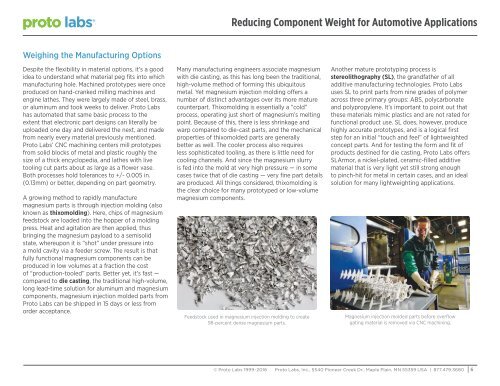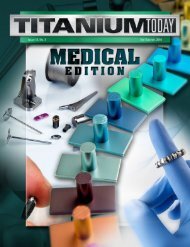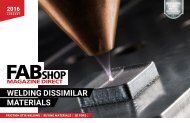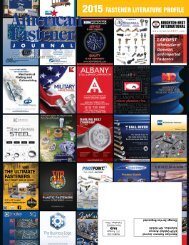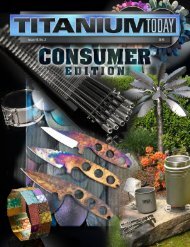Reducing Component Weight for Automotive Applications
1Uz2lLA
1Uz2lLA
You also want an ePaper? Increase the reach of your titles
YUMPU automatically turns print PDFs into web optimized ePapers that Google loves.
<strong>Reducing</strong> <strong>Component</strong> <strong>Weight</strong> <strong>for</strong> <strong>Automotive</strong> <strong>Applications</strong><br />
Weighing the Manufacturing Options<br />
Despite the flexibility in material options, it’s a good<br />
idea to understand what material peg fits into which<br />
manufacturing hole. Machined prototypes were once<br />
produced on hand-cranked milling machines and<br />
engine lathes. They were largely made of steel, brass,<br />
or aluminum and took weeks to deliver. Proto Labs<br />
has automated that same basic process to the<br />
extent that electronic part designs can literally be<br />
uploaded one day and delivered the next, and made<br />
from nearly every material previously mentioned.<br />
Proto Labs’ CNC machining centers mill prototypes<br />
from solid blocks of metal and plastic roughly the<br />
size of a thick encyclopedia, and lathes with live<br />
tooling cut parts about as large as a flower vase.<br />
Both processes hold tolerances to +/- 0.005 in.<br />
(0.13mm) or better, depending on part geometry.<br />
A growing method to rapidly manufacture<br />
magnesium parts is through injection molding (also<br />
known as thixomolding). Here, chips of magnesium<br />
feedstock are loaded into the hopper of a molding<br />
press. Heat and agitation are then applied, thus<br />
bringing the magnesium payload to a semisolid<br />
state, whereupon it is “shot” under pressure into<br />
a mold cavity via a feeder screw. The result is that<br />
fully functional magnesium components can be<br />
produced in low volumes at a fraction the cost<br />
of “production-tooled” parts. Better yet, it’s fast —<br />
compared to die casting, the traditional high-volume,<br />
long lead-time solution <strong>for</strong> aluminum and magnesium<br />
components, magnesium injection molded parts from<br />
Proto Labs can be shipped in 15 days or less from<br />
order acceptance.<br />
Many manufacturing engineers associate magnesium<br />
with die casting, as this has long been the traditional,<br />
high-volume method of <strong>for</strong>ming this ubiquitous<br />
metal. Yet magnesium injection molding offers a<br />
number of distinct advantages over its more mature<br />
counterpart. Thixomolding is essentially a “cold”<br />
process, operating just short of magnesium’s melting<br />
point. Because of this, there is less shrinkage and<br />
warp compared to die-cast parts, and the mechanical<br />
properties of thixomolded parts are generally<br />
better as well. The cooler process also requires<br />
less sophisticated tooling, as there is little need <strong>for</strong><br />
cooling channels. And since the magnesium slurry<br />
is fed into the mold at very high pressure — in some<br />
cases twice that of die casting — very fine part details<br />
are produced. All things considered, thixomolding is<br />
the clear choice <strong>for</strong> many prototyped or low-volume<br />
magnesium components.<br />
Feedstock used in magnesium injection molding to create<br />
98-percent dense magnesium parts.<br />
Another mature prototyping process is<br />
stereolithography (SL), the grandfather of all<br />
additive manufacturing technologies. Proto Labs<br />
uses SL to print parts from nine grades of polymer<br />
across three primary groups: ABS, polycarbonate<br />
and polypropylene. It’s important to point out that<br />
these materials mimic plastics and are not rated <strong>for</strong><br />
functional product use. SL does, however, produce<br />
highly accurate prototypes, and is a logical first<br />
step <strong>for</strong> an initial “touch and feel” of lightweighted<br />
concept parts. And <strong>for</strong> testing the <strong>for</strong>m and fit of<br />
products destined <strong>for</strong> die casting, Proto Labs offers<br />
SLArmor, a nickel-plated, ceramic-filled additive<br />
material that is very light yet still strong enough<br />
to pinch-hit <strong>for</strong> metal in certain cases, and an ideal<br />
solution <strong>for</strong> many lightweighting applications.<br />
Magnesium injection molded parts be<strong>for</strong>e overflow<br />
gating material is removed via CNC machining.<br />
© Proto Labs 1999–2016 Proto Labs, Inc., 5540 Pioneer Creek Dr., Maple Plain, MN 55359 USA | 877.479.3680<br />
6


